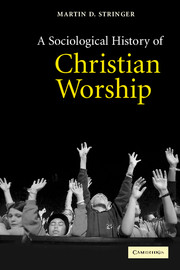Book contents
- Frontmatter
- Contents
- Preface and acknowledgements
- Introduction: Discourse, devotion and embodiment
- 1 Early Christian worship, texts and contexts to ad 300
- 2 Worship and the Christianisation of public space, 300–600
- 3 Hegemonic discourses in the worship of empires, 600–900
- 4 The dominant discourse of cosmological Christianity, 900–1200
- 5 Accessing the demotic discourses of devotion, 1200–1500
- 6 Worship and the rise of humanistic discourses, 1500–1800
- 7 The globalisation of Christian worship, 1800–2000
- Bibliography
- Index
5 - Accessing the demotic discourses of devotion, 1200–1500
Published online by Cambridge University Press: 03 December 2009
- Frontmatter
- Contents
- Preface and acknowledgements
- Introduction: Discourse, devotion and embodiment
- 1 Early Christian worship, texts and contexts to ad 300
- 2 Worship and the Christianisation of public space, 300–600
- 3 Hegemonic discourses in the worship of empires, 600–900
- 4 The dominant discourse of cosmological Christianity, 900–1200
- 5 Accessing the demotic discourses of devotion, 1200–1500
- 6 Worship and the rise of humanistic discourses, 1500–1800
- 7 The globalisation of Christian worship, 1800–2000
- Bibliography
- Index
Summary
INTRODUCTION: DEMOTIC DISCOURSES
At the end of the previous chapter I referred in passing to the concept of ‘devotion’ in relation to lay participation in medieval liturgy. I suggested that ordinary worshippers might be engaged in their own form of devotional habitus while the official, dominant, cosmological discourses were being presented in the liturgy itself. Up to this point, however, I have hardly explored the distinction between liturgy and devotion at all. This is partly because for much of the first thousand years of Christian history official liturgical worship and lay devotion were largely indistinguishable; each fed off and into the other. To some extent this is also true of the medieval period. A hard and fast distinction is impossible to make and each one would not exist without the other. In this chapter, however, I do want to focus more closely on this particular distinction and I want to relate it to the understanding of discourse that I have developed throughout the book. More specifically, I want to explore the distinction between ‘dominant’ and ‘demotic’ discourses within later medieval Christianity and explore how this relates to understandings of worship at this time.
Gerd Baumann introduced the concepts of ‘demotic’ and ‘dominant’ discourse in his discussion of the role of religion and community in a contemporary West London suburb.
- Type
- Chapter
- Information
- A Sociological History of Christian Worship , pp. 150 - 178Publisher: Cambridge University PressPrint publication year: 2005



